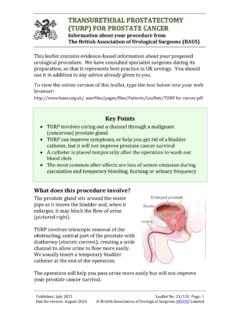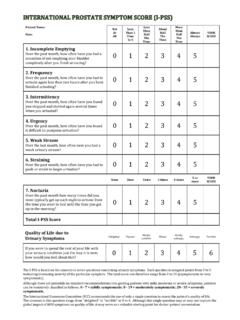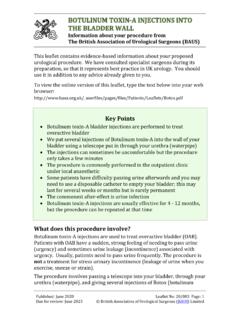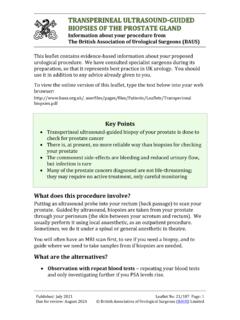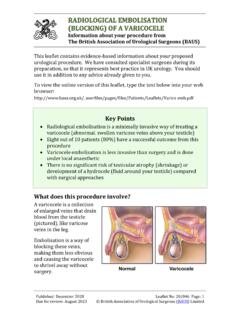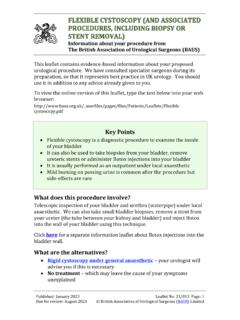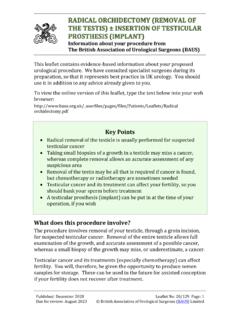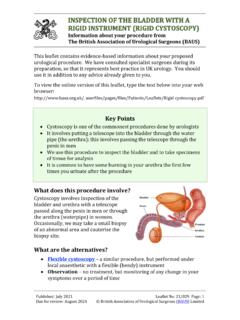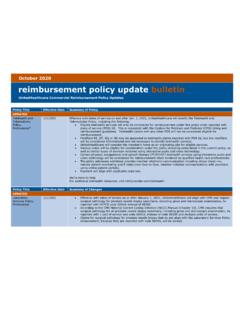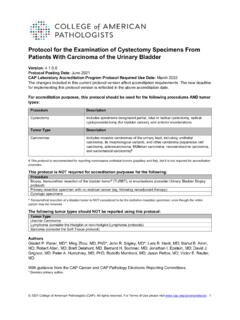Transcription of Key Points - BAUS
1 Information about your procedure from The British Association of Urological Surgeons (BAUS) Published: June 2021 Leaflet No: 20/095 Page: 1 Due for review: June 2024 British Association of Urological Surgeons (BAUS) Limited This leaflet contains evidence-based information about your proposed urological procedure. We have consulted specialist surgeons during its preparation, so that it represents best practice in UK urology. You should use it in addition to any advice already given to you. To view the online version of this leaflet, type the text below into your web browser: What does this procedure involve? The prostate gland sits around the water pipe as it leaves the bladder and, when it enlarges, it may block the flow of urine (pictured right). The procedure involves passing a telescope through your urethra (waterpipe) and peeling out the central part of your prostate gland using a laser; this creates a wide channel which allows urine to flow more easily.
2 We usually insert a temporary bladder catheter at the end of the operation. Key Points HoLEP involves removing obstructing prostate tissue using a laser fibre passed along a telescope through your penis (waterpipe) It is very effective at improving your urinary symptoms related to bladder outflow obstruction, and for men suffering from retention of urine who are dependent on a urinary catheter You will have a catheter in your bladder for 24 to 72 hours after the operation to wash out blood clots The most common after-effects are loss of semen emission during ejaculation and temporary bleeding, burning or urinary frequency Published: June 2021 Leaflet No: 21/095 Page: 2 Due for review: June 2024 British Association of Urological Surgeons (BAUS) Limited What are the alternatives? Observation no treatment using drugs or surgery, but monitoring of any change in your symptoms; symptoms in some men can improve over time without any treatment or with the use of lifestyle interventions Medications to improve urine flow (or to shrink the prostate ) Common ly used medications include tamsulosin, doxazosin, terazosin, finasteride & dutasteride Permanent catheterisation this bypasses the prostate obstruction and may be a long-term option for men who are not considered suitable for surgery Intermittent self-catheterisation this involves men passing a disposable catheter into the bladder to drain it.
3 It is an alternative to permanent catheterisation (above) for men who cannot pass urine or who are unfit to undergo surgery Other surgical procedures including green light laser prostatectomy or open surgery. Newer, minimally-invasive surgical alternatives, now increasingly available to patients, include prostate artery embolisation (PAE), Rez m steam therapy and Urolift What happens on the day of the procedure? Your urologist (or a member of their team) will briefly review your history and medications, and will discuss the surgery again with you to confirm your consent. An anaesthetist will see you to discuss the options of a general anaesthetic or spinal anaesthetic. The anaesthetist will also discuss pain relief after the procedure with you. We may provide you with a pair of TED stockings to wear, and we may give you a heparin injection to thin your blood.
4 These help to prevent blood clots from developing and passing into your lungs. Your medical team will decide whether you need to continue these after you go home. Details of the procedure we normally use a a general anaesthetic (where you are asleep) or a spinal anaesthetic (where you are unable to feel anything from your waist down) we usually give you an injection of antibiotics before the procedure, after you have been checked for any allergies Published: June 2021 Leaflet No: 21/095 Page: 3 Due for review: June 2024 British Association of Urological Surgeons (BAUS) Limited we pass a telescope into your bladder through the urethra (water pipe) and use a laser fibre (pictured) to peel away pieces of the obstructing prostate tissue ( prostate lobes) from the surrounding capsule of the prostate .
5 The peeled pieces are flushed into the bladder we morcellate (chop up) and suck out the pieces of prostate , using a special instrument (a morcellator) passed into your bladder through the telescope we send the prostate tissue that has been removed for microscopic pathology analysis once the prostate has been removed, we carefully laser any bleeding Points in the cavity left by the surgery we put a catheter into your bladder at the end of the procedure we normally use bladder irrigation through the catheter to flush through any clots or bleeding for a brief period after the surgery on average, the procedure usually takes abut two hours to complete, depending on the size of your prostate you can usually expect to be in hospital for one night but, in some patients, surgery can be done as a day case We normally remove your bladder catheter within the first 1-2 days after your surgery.
6 You may find it painful to pass urine at first and it may come more frequently than normal. You can relieve any initial discomfort with painkillers such as Paracetamol, and frequent passage of urine usually begins to improve within a few days. The laser technique removes a lot of tissue so you may find your urinary control is not perfect at first. This improves as your pelvic floor muscles recover from the surgery and, for most men, this settles over a short period of time. Your urine may turn bloody for 24 to 48 hours after removal of your catheter and some patients cannot pass urine at this stage. If this happens, we put another catheter in temporarily, to allow any swelling related to the operation to settle. Usually, you then go home with this catheter and return a week or so later for a second catheter removal; this is successful in almost all patients.
7 Published: June 2021 Leaflet No: 21/095 Page: 4 Due for review: June 2024 British Association of Urological Surgeons (BAUS) Limited Further information and a video of HoLEP are available on the BAUS website. Are there any after-effects? The possible after-effects and your risk of getting them are shown below. Some are self-limiting or reversible, but others are not. We have not listed very rare after-effects (occurring in less than 1 in 250 patients) individually. The impact of these after-effects can vary a lot from patient to patient; you should discuss with your surgeon the risks and their impact on you as an individual: After-effect Risk Temporary mild burning, bleeding and frequent urination Almost all patients No semen is produced because it passes back into your bladder on ejaculation (retrograde ejaculation) In 9 out of 10 patients (90%) Continuing blood in your urine for several days after surgery Between 1 in 2 & 1 in 10 patients Temporary short-term loss of urinary control which can be imnporved with pelvic floor exercises Between 1 in 10 & 1 in 50 patients Treatment may not relieve all your symptoms Between 1 in 50 & 1 in 250 patients Bleeding requiring a blood transfusion or re-operation Between 1 in 50 & 1 in 250 patients Anaesthetic or cardiovascular problems possibly requiring intensive care (including chest infection, pulmonary embolus, stroke, deep vein thrombosis, heart attack and death)
8 Between 1 in 50 & 1 in 250 patients (your anaesthetist can estimate your individual risk) Published: June 2021 Leaflet No: 21/095 Page: 5 Due for review: June 2024 British Association of Urological Surgeons (BAUS) Limited What is my risk of a hospital-acquired infection? Your risk of getting an infection in hospital is between 4 this includes getting MRSA or a Clostridium difficile bowel infection. This figure is higher if you are in a high-risk group of patients such as patients who have had: long-term drainage tubes ( catheters); long hospital stays; or multiple hospital admissions. What can I expect when I get home? you will be given advice about your recovery at home you will be given a copy of your discharge summary and a copy will also be sent to your GP any antibiotics or other tablets you may need will be arranged & dispensed from the hospital pharmacy you should drink twice as much fluid as you would normally for the first 24 to 48 hours, to flush your system through and reduce the risk of infection you may return to work when you are comfortable enough and when your GP is satisfied with your progress one patient in five (20%) gets some bleeding 2-3 weeks after getting home, due to scabs separating from the cavity of the prostate .
9 If this happens, you should increase your drinking; if it does not settle, you should contact your GP who will prescribe antibiotics for you if you have severe bleeding, pass blood clots or have sudden difficulty passing urine, you should contact your GP immediately; this may re-admission as an emergency Some loss of urinary control is common in the early days, so it is helpful to start pelvic floor exercises as soon as possible; these can improve your control when you get home. Click the link for further information on these exercises, or contact your urology Specialist Nurse. The symptoms of an overactive bladder (frequent & urgent urination) can take up to three months to settle, whereas the flow of urine is usually improved immediately. It will usually be 14 to 21 days before the final biopsy results on the tissue removed are available.
10 All biopsies that unexpectedly show cancer in your prostatre are discussed in detail at a specialist multi-disciplinary meeting before any further treatment decisions are made. You and your GP will be informed of the results after a discussion with your specialist team. Published: June 2021 Leaflet No: 21/095 Page: 6 Due for review: June 2024 British Association of Urological Surgeons (BAUS) Limited Most patients need two to three weeks at home before they feel ready for work. We recommend three to four weeks rest before you go back to work, especially if your job is physically demanding; you should avoid any heavy lifting during the recovery period. General information about surgical procedures Before your procedure Please tell a member of the medical team if you have: an implanted foreign body (stent, joint replacement, pacemaker, heart valve, blood vessel graft); a regular prescription for a blood thinning agent ( warfarin, aspirin, clopidogrel, rivaroxaban, dabigatran); a present or previous MRSA infection; or a high risk of variant-CJD ( if you have had a corneal transplant, a neurosurgical dural transplant or human growth hormone treatment).
